遗传算法模拟退火matlab编程
(仅供参考)现代算法(遗传算法,退火算法)含(matlab程序和工具箱介绍)
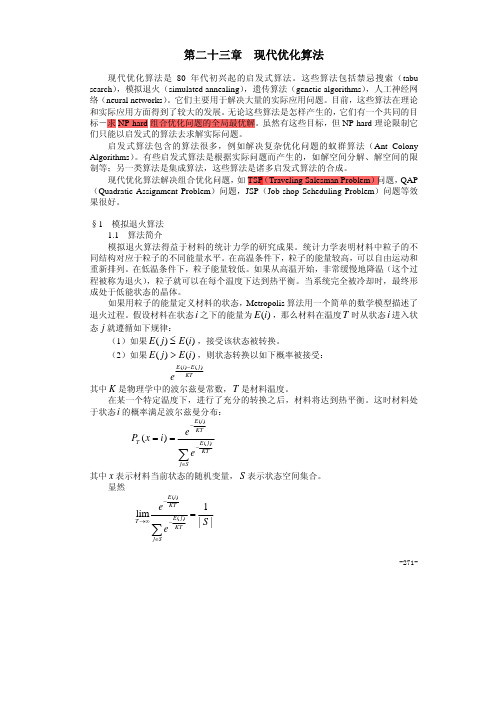
-271-第二十三章 现代优化算法现代优化算法是80年代初兴起的启发式算法。
这些算法包括禁忌搜索(tabu search ),模拟退火(simulated annealing ),遗传算法(genetic algorithms ),人工神经网络(neural networks )。
它们主要用于解决大量的实际应用问题。
目前,这些算法在理论和实际应用方面得到了较大的发展。
无论这些算法是怎样产生的,它们有一个共同的目标-求NP-hard 组合优化问题的全局最优解。
虽然有这些目标,但NP-hard 理论限制它们只能以启发式的算法去求解实际问题。
启发式算法包含的算法很多,例如解决复杂优化问题的蚁群算法(Ant Colony Algorithms )。
有些启发式算法是根据实际问题而产生的,如解空间分解、解空间的限制等;另一类算法是集成算法,这些算法是诸多启发式算法的合成。
现代优化算法解决组合优化问题,如TSP (Traveling Salesman Problem )问题,QAP (Quadratic Assignment Problem )问题,JSP (Job-shop Scheduling Problem )问题等效果很好。
§1 模拟退火算法1.1 算法简介模拟退火算法得益于材料的统计力学的研究成果。
统计力学表明材料中粒子的不同结构对应于粒子的不同能量水平。
在高温条件下,粒子的能量较高,可以自由运动和重新排列。
在低温条件下,粒子能量较低。
如果从高温开始,非常缓慢地降温(这个过程被称为退火),粒子就可以在每个温度下达到热平衡。
当系统完全被冷却时,最终形成处于低能状态的晶体。
如果用粒子的能量定义材料的状态,Metropolis 算法用一个简单的数学模型描述了退火过程。
假设材料在状态i 之下的能量为)(i E ,那么材料在温度T 时从状态i 进入状态j 就遵循如下规律:(1)如果)()(i E j E ≤,接受该状态被转换。
matlab模拟退火法

模拟退火算法是一种基于物理中退火过程的优化算法,适用于解决全局优化问题。
以下是一个基本的MATLAB模拟退火算法实现示例:
matlab
function SA()
% 参数设置
T = 1000; % 初始温度
alpha = 0.95; % 降温系数
x = rand(1,10); % 初始解
f = @(x) sum(x.^2 - 10*cos(2*pi*x) + 10); % 目标函数
while T > 1e-5
% 随机生成新解
x_new = x + randn(1,10);
% 计算新解的函数值
f_new = f(x_new);
% 计算接受概率
p = exp(-(f_new - f(x))/T);
% 以概率p接受新解,否则拒绝
if rand() < p
x = x_new;
f = f_new;
end
% 降温
T = T*alpha;
end
% 输出最优解和最优值
fprintf('最优解:%f\n', x);
fprintf('最优值:%f\n', f);
end
这个示例中,我们定义了一个目标函数f,它是一个简单的多峰函数。
我们使用一个随机生成的初始解作为初始解x,然后在一个循环中不断生成新的解,并计算其函数值。
我们根据接受概率决定是否接受新解,如果新解更好,则接受;否则,我们以一定的概率接受新解。
在每次迭代中,我们都会降低温度T,直到达到预设的终止条件。
最后,我们输出最优解和最优值。
模拟退火算法及其Matlab实现

模拟退⽕算法及其Matlab实现1基本原理:模拟退⽕算法源于固体的退⽕过程,当把⼀个固体的加热使其升温,其内部分⼦出现⽆序状态,内能增⼤⽽降温时,所有粒⼦趋于有序,冷却到最低温度时内能达到最少。
当某⼀状态下系统内能减少,则完全接受这⼀新的状态,否则对于这⼀状态采样概率接受,温度越⾼,接受的概率越⼤。
当温度由初始值逐渐降到最低温度时,即可得到最低的内能,也就是算法的最优解。
2算法步骤:(1)设置算法的参数:初始温度,结束温度,温度衰减系数,每个温度下的扰动次数,初始状态,初始解(2)对状态产⽣扰动,计算新状态下的解,⽐较两个解的⼤⼩,判断是否接受新的状态(3)在此温度下,对步骤(2)按设置的扰动次数重复进⾏扰动(4)对温度进⾏衰减,并在新的温度下重复(2)(3),直到结束温度(5)输出记录最优状态和最优解,算法结束3实例计算:采⽤TSP问题中的eil51数据,官⽅的最优解为426,编写Matlab程序,进⾏计算4Matlab代码:clc,clear %清空环境中的变量ticiter = 1; % 迭代次数初值a=0.99; %温度衰减系数t0=120; %初始温度tf=1; %最后温度t=t0;Markov=10000; %Markov链长度load data1.txt %读⼊城市的坐标city=data1;n = size(city,1); %城市距离初始化D = zeros(n,n);for i = 1:nfor j = 1:nD(i,j) = sqrt(sum((city(i,:) - city(j,:)).^2));endendroute=1:n;route_new=route;best_length=Inf;Length=Inf;best_route=route;%%while t>=tffor j=1:Markov%进⾏扰动,长⽣新的序列route_new;if (rand<0.7)%交换两个数的顺序ind1=0;ind2=0;while(ind1==ind2&&ind1>=ind2)ind1=ceil(rand*n);ind2=ceil(rand*n);endtemp=route_new(ind1);route_new(ind1)=route_new(ind2);route_new(ind2)=temp;elseind=zeros(3,1);L_ind=length(unique(ind));while (L_ind<3)ind=ceil([rand*n rand*n rand*n]);L_ind=length(unique(ind));endind0=sort(ind);a1=ind0(1);b1=ind0(2);c1=ind0(3);route0=route_new;route0(a1:a1+c1-b1-1)=route_new(b1+1:c1);route0(a1+c1-b1:c1)=route_new(a1:b1);route_new=route0;end%计算路径的距离,Length_newlength_new = 0;Route=[route_new route_new(1)];for j = 1:nlength_new = length_new+ D(Route(j),Route(j + 1)); endif length_new<LengthLength=length_new;route=route_new;%对最优路线和距离更新if length_new<best_lengthiter = iter + 1;best_length=length_new;best_route=route_new;endelseif rand<exp(-(length_new-Length)/t)route=route_new;Length=length_new;endendroute_new=route;endt=t*a;end%--------------------------------------------------------------------------%% 结果显⽰tocRoute=[best_route best_route(1)];plot([city(Route ,1)], [city(Route ,2)],'o-');disp('最优解为:')disp(best_route)disp('最短距离:')disp(best_length)disp('最优解迭代次数:')disp(iter)for i = 1:n%对每个城市进⾏标号text(city(i,1),city(i,2),['' num2str(i)]);endxlabel('城市位置横坐标')ylabel('城市位置纵坐标')title(['模拟退⽕算法(最短距离):' num2str(best_length) ''])5运⾏结果:最短距离:436.7146,其和最优解426接近TSP图:。
遗传算法matlab程序代码

遗传算法matlab程序代码
遗传算法(GA)是一种用于求解优化问题的算法,其主要思想是模拟
生物进化过程中的“选择、交叉、变异”操作,通过模拟这些操作,来寻
找最优解。
Matlab自带了GA算法工具箱,可以直接调用来实现遗传算法。
以下是遗传算法Matlab程序代码示例:
1.初始化
首先定义GA需要优化的目标函数f,以及GA算法的相关参数,如种
群大小、迭代次数、交叉概率、变异概率等,如下所示:
options = gaoptimset('PopulationSize',10,...
'Generations',50,...
2.运行遗传算法
运行GA算法时,需要调用MATLAB自带的ga函数,将目标函数、问
题的维度、上下界、约束条件和算法相关参数作为输入参数。
其中,上下
界和约束条件用于限制空间,防止到无效解。
代码如下:
[某,fval,reason,output,population] = ga(f,2,[],[],[],[],[-10,-10],[10,10],[],options);
3.结果分析
最后,将结果可视化并输出,可以使用Matlab的plot函数绘制出目
标函数的值随迭代次数的变化,如下所示:
plot(output.generations,output.bestf)
某label('Generation')
ylabel('Best function value')
总之,Matlab提供了方便易用的GA算法工具箱,开发者只需要根据具体问题定义好目标函数和相关参数,就能够在短时间内快速实现遗传算法。
模拟退火算法和遗传算法

模拟退⽕算法和遗传算法爬⼭算法在介绍这两种算法前,先介绍⼀下爬⼭算法。
爬⼭算法是⼀种简单的贪⼼搜索算法,该算法每次从当前解的临近解空间中选择⼀个最优解作为当前解,直到达到⼀个局部最优解。
爬⼭算法实现很简单,其主要缺点是会陷⼊局部最优解,⽽不⼀定能搜索到全局最优解。
如图1所⽰:假设C点为当前解,爬⼭算法搜索到A点这个局部最优解就会停⽌搜索,因为在A点⽆论向那个⽅向⼩幅度移动都不能得到更优的解。
模拟退⽕算法(SA)为了解决局部最优解问题, 1983年,Kirkpatrick等提出了模拟退⽕算法(SA)能有效的解决局部最优解问题。
模拟退⽕其实也是⼀种贪⼼算法,但是它的搜索过程引⼊了随机因素。
模拟退⽕算法以⼀定的概率来接受⼀个⽐当前解要差的解,因此有可能会跳出这个局部的最优解,达到全局的最优解。
算法介绍我们知道在分⼦和原⼦的世界中,能量越⼤,意味着分⼦和原⼦越不稳定,当能量越低时,原⼦越稳定。
“退⽕”是物理学术语,指对物体加温在冷却的过程。
模拟退⽕算法来源于晶体冷却的过程,如果固体不处于最低能量状态,给固体加热再冷却,随着温度缓慢下降,固体中的原⼦按照⼀定形状排列,形成⾼密度、低能量的有规则晶体,对应于算法中的全局最优解。
⽽如果温度下降过快,可能导致原⼦缺少⾜够的时间排列成晶体的结构,结果产⽣了具有较⾼能量的⾮晶体,这就是局部最优解。
因此就可以根据退⽕的过程,给其在增加⼀点能量,然后在冷却,如果增加能量,跳出了局部最优解,这本次退⽕就是成功的。
算法原理模拟退⽕算法包含两个部分即Metropolis算法和退⽕过程。
Metropolis算法就是如何在局部最优解的情况下让其跳出来,是退⽕的基础。
1953年Metropolis提出重要性采样⽅法,即以概率来接受新状态,⽽不是使⽤完全确定的规则,称为Metropolis准则。
状态转换规则温度很低时,材料以很⼤概率进⼊最⼩能量状态模拟退⽕寻优⽅法注意事项理论上,降温过程要⾜够缓慢,使得在每⼀温度下达到热平衡。
模拟退火算法(MATLAB实现)

实验用例:用模拟退火算法解决如下10个城市的TSP 问题,该问题最优解为691.2 opt f 。
表1 10个城市的坐标城市 X 坐标 Y 坐标 城市 X 坐标 Y 坐标3 0.4000 0.4439 8 0.8732 0.6536编程实现用MATLAB 实现模拟退火算法时,共编制了5个m 文件,分别如下 1、swap.mfunction [ newpath , position ] = swap( oldpath , number ) % 对 oldpath 进 行 互 换 操 作% number 为 产 生 的 新 路 径 的 个 数 % position 为 对 应 newpath 互 换 的 位 置 m = length( oldpath ) ; % 城 市 的 个 数 newpath = zeros( number , m ) ;position = sort( randi( m , number , 2 ) , 2 ); % 随 机 产 生 交 换 的 位 置 for i = 1 : numbernewpath( i , : ) = oldpath ;% 交 换 路 径 中 选 中 的 城 市newpath( i , position( i , 1 ) ) = oldpath( position( i , 2 ) ) ;newpath( i , position( i , 2 ) ) = oldpath( position( i , 1 ) ) ; end2、pathfare.mfunction [ objval ] = pathfare( fare , path ) % 计 算 路 径 path 的 代 价 objval% path 为 1 到 n 的 排 列 ,代 表 城 市 的 访 问 顺 序 ; % fare 为 代 价 矩 阵 , 且 为 方 阵 。
[ m , n ] = size( path ) ; objval = zeros( 1 , m ) ; for i = 1 : mfor j = 2 : nobjval( i ) = objval( i ) + fare( path( i , j - 1 ) , path( i , j ) ) ; endobjval( i ) = objval( i ) + fare( path( i , n ) , path( i , 1 ) ) ; end3、distance.mfunction [ fare ] = distance( coord )% 根据各城市的距离坐标求相互之间的距离% fare 为各城市的距离,coord 为各城市的坐标[ ~ , m ] = size( coord ) ; % m 为城市的个数fare = zeros( m ) ;for i = 1 : m % 外层为行for j = i : m % 内层为列fare( i , j ) = ...( sum( ( coord( : , i ) - coord( : , j ) ) .^ 2 ) ) ^ 0.5 ;fare( j , i ) = fare( i , j ) ; % 距离矩阵对称endend4、myplot.mfunction [ ] = myplot( path , coord , pathfar )% 做出路径的图形% path 为要做图的路径,coord 为各个城市的坐标% pathfar 为路径path 对应的费用len = length( path ) ;clf ;hold on ;title( [ '近似最短路径如下,费用为' , num2str( pathfar ) ] ) ;plot( coord( 1 , : ) , coord( 2 , : ) , 'ok');pause( 0.4 ) ;for ii = 2 : lenplot( coord( 1 , path( [ ii - 1 , ii ] ) ) , coord( 2 , path( [ ii - 1 , ii ] ) ) , '-b');x = sum( coord( 1 , path( [ ii - 1 , ii ] ) ) ) / 2 ;y = sum( coord( 2 , path( [ ii - 1 , ii ] ) ) ) / 2 ;text( x , y , [ '(' , num2str( ii - 1 ) , ')' ] ) ;pause( 0.4 ) ;endplot( coord( 1 , path( [ 1 , len ] ) ) , coord( 2 , path( [ 1 , len ] ) ) , '-b' ) ;x = sum( coord( 1 , path( [ 1 , len ] ) ) ) / 2 ;y = sum( coord( 2 , path( [ 1 , len ] ) ) ) / 2 ;text( x , y , [ '(' , num2str( len ) , ')' ] ) ;pause( 0.4 ) ;hold off ;5、mySAA.m% 模拟退火算法( Simulated Annealing Algorithm ) MATLAB 程序% 程序参数设定Coord = ... % 城市的坐标Coordinates[ 0.6683 0.6195 0.4 0.2439 0.1707 0.2293 0.5171 0.8732 0.6878 0.8488 ; ...0.2536 0.2634 0.4439 0.1463 0.2293 0.761 0.9414 0.6536 0.5219 0.3609 ] ;t0 = 1 ; % 初温t0iLk = 20 ; % 内循环最大迭代次数iLkoLk = 50 ; % 外循环最大迭代次数oLklam = 0.95 ; % λ lambdaistd = 0.001 ; % 若内循环函数值方差小于istd 则停止ostd = 0.001 ; % 若外循环函数值方差小于ostd 则停止ilen = 5 ; % 内循环保存的目标函数值个数olen = 5 ; % 外循环保存的目标函数值个数% 程序主体m = length( Coord ) ; % 城市的个数mfare = distance( Coord ) ; % 路径费用farepath = 1 : m ; % 初始路径pathpathfar = pathfare( fare , path ) ; % 路径费用path fareores = zeros( 1 , olen ) ; % 外循环保存的目标函数值e0 = pathfar ; % 能量初值e0t = t0 ; % 温度tfor out = 1 : oLk % 外循环模拟退火过程ires = zeros( 1 , ilen ) ; % 内循环保存的目标函数值for in = 1 : iLk % 内循环模拟热平衡过程[ newpath , ~ ] = swap( path , 1 ) ; % 产生新状态e1 = pathfare( fare , newpath ) ; % 新状态能量% Metropolis 抽样稳定准则r = min( 1 , exp( - ( e1 - e0 ) / t ) ) ;if rand < rpath = newpath ; % 更新最佳状态e0 = e1 ;endires = [ ires( 2 : end ) e0 ] ; % 保存新状态能量% 内循环终止准则:连续ilen 个状态能量波动小于istd if std( ires , 1 ) < istdbreak ;endendores = [ ores( 2 : end ) e0 ] ; % 保存新状态能量% 外循环终止准则:连续olen 个状态能量波动小于ostd if std( ores , 1 ) < ostdbreak ;endt = lam * t ;pathfar = e0 ;% 输 入 结 果fprintf( '近似最优路径为:\n ' )%disp( char( [ path , path(1) ] + 64 ) ) ; disp(path)fprintf( '近似最优路径费用\tpathfare=' ) ; disp( pathfar ) ;myplot( path , Coord , pathfar ) ;一次运行结果如下:0.10.20.30.40.50.60.70.80.90.10.20.30.40.50.60.70.80.91近似最短路径如下,费用为2.6907我试着运行了几次(只是改变了一下初温,也可以更改一下其他参数),发现初始温度t0=1时程序的最后结果与最优解差距小的概率比较大。
模拟退火算法原理及matlab源代码

模拟退火算法模拟退火算法是一种通用的随机搜索算法,是局部搜索算法的扩展。
它的思想是再1953年由metropolis提出来的,到1983年由kirkpatrick等人成功地应用在组合优化问题中。
模拟退火算法来源于固体退火原理,将固体加温至充分高,再让其徐徐冷却,加温时,固体内部粒子随温升变为无序状,内能增大,而徐徐冷却时粒子渐趋有序,在每个温度都达到平衡态,最后在常温时达到基态,内能减为最小。
根据Metropolis准则,粒子在温度T时趋于平衡的概率为e-ΔE/(kT),其中E为温度T时的内能,ΔE为其改变量,k为Boltzmann常数。
用固体退火模拟组合优化问题,将内能E模拟为目标函数值f,温度T演化成控制参数t,即得到解组合优化问题的模拟退火算法:由初始解i和控制参数初值t开始,对当前解重复“产生新解→计算目标函数差→接受或舍弃”的迭代,并逐步衰减t值,算法终止时的当前解即为所得近似最优解,这是基于蒙特卡罗迭代求解法的一种启发式随机搜索过程。
退火过程由冷却进度表(Cooling Schedule)控制,包括控制参数的初值t及其衰减因子Δt、每个t值时的迭代次数L和停止条件S。
模拟退火算法新解的产生和接受可分为如下四个步骤:第一步是由一个产生函数从当前解产生一个位于解空间的新解;为便于后续的计算和接受,减少算法耗时,通常选择由当前新解经过简单地变换即可产生新解的方法,如对构成新解的全部或部分元素进行置换、互换等,注意到产生新解的变换方法决定了当前新解的邻域结构,因而对冷却进度表的选取有一定的影响。
第二步是计算与新解所对应的目标函数差。
因为目标函数差仅由变换部分产生,所以目标函数差的计算最好按增量计算。
事实表明,对大多数应用而言,这是计算目标函数差的最快方法。
第三步是判断新解是否被接受,判断的依据是一个接受准则,最常用的接受准则是Metropo1is准则: 若Δt′<0则接受S′作为新的当前解S,否则以概率exp(-Δt′/T)接受S′作为新的当前解S。
模拟退火算法及其Matlab实现
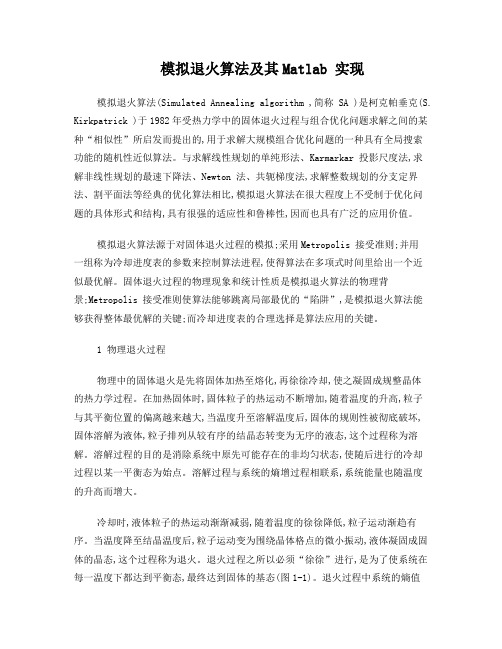
模拟退火算法及其Matlab 实现模拟退火算法(Simulated Annealing algorithm ,简称SA )是柯克帕垂克(S. Kirkpatrick )于1982年受热力学中的固体退火过程与组合优化问题求解之间的某种“相似性”所启发而提出的,用于求解大规模组合优化问题的一种具有全局搜索功能的随机性近似算法。
与求解线性规划的单纯形法、Karmarkar 投影尺度法,求解非线性规划的最速下降法、Newton 法、共轭梯度法,求解整数规划的分支定界法、割平面法等经典的优化算法相比,模拟退火算法在很大程度上不受制于优化问题的具体形式和结构,具有很强的适应性和鲁棒性,因而也具有广泛的应用价值。
模拟退火算法源于对固体退火过程的模拟;采用Metropolis 接受准则;并用一组称为冷却进度表的参数来控制算法进程,使得算法在多项式时间里给出一个近似最优解。
固体退火过程的物理现象和统计性质是模拟退火算法的物理背景;Metropolis 接受准则使算法能够跳离局部最优的“陷阱”,是模拟退火算法能够获得整体最优解的关键;而冷却进度表的合理选择是算法应用的关键。
1 物理退火过程物理中的固体退火是先将固体加热至熔化,再徐徐冷却,使之凝固成规整晶体的热力学过程。
在加热固体时,固体粒子的热运动不断增加,随着温度的升高,粒子与其平衡位置的偏离越来越大,当温度升至溶解温度后,固体的规则性被彻底破坏,固体溶解为液体,粒子排列从较有序的结晶态转变为无序的液态,这个过程称为溶解。
溶解过程的目的是消除系统中原先可能存在的非均匀状态,使随后进行的冷却过程以某一平衡态为始点。
溶解过程与系统的熵增过程相联系,系统能量也随温度的升高而增大。
冷却时,液体粒子的热运动渐渐减弱,随着温度的徐徐降低,粒子运动渐趋有序。
当温度降至结晶温度后,粒子运动变为围绕晶体格点的微小振动,液体凝固成固体的晶态,这个过程称为退火。
退火过程之所以必须“徐徐”进行,是为了使系统在每一温度下都达到平衡态,最终达到固体的基态(图1-1)。
遗传算法在matlab中的实现
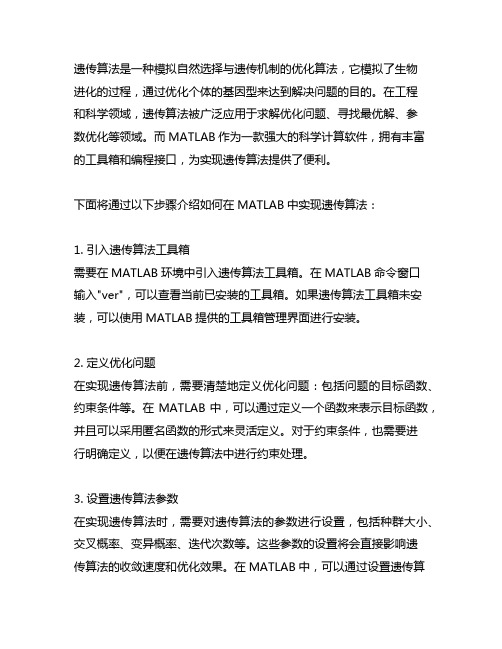
遗传算法是一种模拟自然选择与遗传机制的优化算法,它模拟了生物进化的过程,通过优化个体的基因型来达到解决问题的目的。
在工程和科学领域,遗传算法被广泛应用于求解优化问题、寻找最优解、参数优化等领域。
而MATLAB作为一款强大的科学计算软件,拥有丰富的工具箱和编程接口,为实现遗传算法提供了便利。
下面将通过以下步骤介绍如何在MATLAB中实现遗传算法:1. 引入遗传算法工具箱需要在MATLAB环境中引入遗传算法工具箱。
在MATLAB命令窗口输入"ver",可以查看当前已安装的工具箱。
如果遗传算法工具箱未安装,可以使用MATLAB提供的工具箱管理界面进行安装。
2. 定义优化问题在实现遗传算法前,需要清楚地定义优化问题:包括问题的目标函数、约束条件等。
在MATLAB中,可以通过定义一个函数来表示目标函数,并且可以采用匿名函数的形式来灵活定义。
对于约束条件,也需要进行明确定义,以便在遗传算法中进行约束处理。
3. 设置遗传算法参数在实现遗传算法时,需要对遗传算法的参数进行设置,包括种群大小、交叉概率、变异概率、迭代次数等。
这些参数的设置将会直接影响遗传算法的收敛速度和优化效果。
在MATLAB中,可以通过设置遗传算法工具箱中的相关函数来完成参数的设置。
4. 编写遗传算法主程序编写遗传算法的主程序,主要包括对适应度函数的计算、选择、交叉、变异等操作。
在MATLAB中,可以利用遗传算法工具箱提供的相关函数来实现这些操作,简化了遗传算法的实现过程。
5. 运行遗传算法将编写好的遗传算法主程序在MATLAB环境中运行,并观察优化结果。
在运行过程中,可以对结果进行实时监测和分析,以便对遗传算法的参数进行调整和优化。
通过以上步骤,可以在MATLAB中实现遗传算法,并应用于实际的优化问题与工程应用中。
遗传算法的实现将大大提高问题的求解效率与精度,为工程领域带来更多的便利与可能性。
总结:遗传算法在MATLAB中的实现涉及到了引入遗传算法工具箱、定义优化问题、设置算法参数、编写主程序和运行算法等步骤。
遗传模拟退火算法在MATLAB上的编程实现
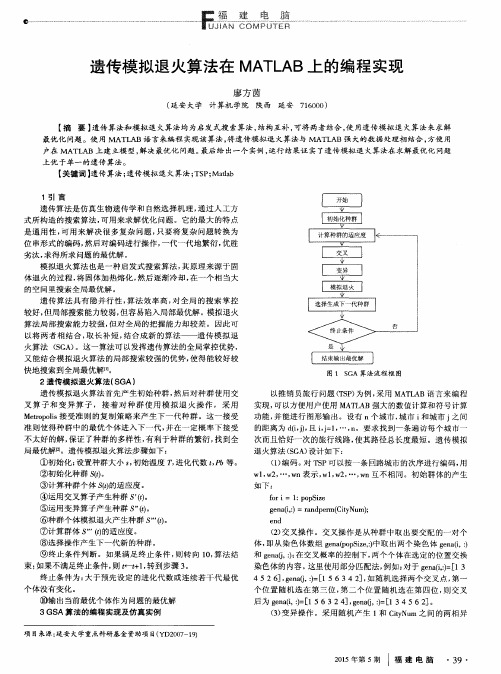
… ~ … …
C 0 p UT 辩
遗传 模拟退火算 法在 MA T L A B上 的编 程实现
廖 方茵
( 延安大学 计算机 学院 陕西 延 安 7 1 6 0 0 0 )
【 摘 要】 遗 传算法和模拟退 火算 法均为启发 式搜 索算法 , 结构互补 , 可将 两者结合 , 使 用遗传模拟退 火算 法来求解
如下:
f o r i= 1 : po p Si z e
③计算种群个 体 s ) 的适应度 。
④运用交叉算子产 生种群 S ’ ( ) 。 ⑤运用变异算子产 生种群 s ” ∽。 ⑥种群个体模拟退火产 生种群 S f c 1 0 ⑦计算群体 S ” ’ ( ) 的适应度 。
⑧ 选 择 操 作 产 生下 一 代 新 的种 群 。 ⑨ห้องสมุดไป่ตู้终止条件判 断。如果满足 终止条件 , 则转 向 1 0 , 算 法 结
g e n a ( i , : ) =r a n d p e r m ( C i t y N u m) ;
e n d
( 2 ) 交 叉 操 作 。交 叉操 作 是 从 种 群 中取 出要 交 配 的 一 对 个 体, 即从染色体数组 g e n a ( p o p S i z e , : ) 中取 出 两 个 染 色 体 g e n a ( i , : ) 和g e n a 0 , : ) ; 在 交 叉 概 率 的控 制 下 , 两 个 个 体 在 选 定 的 位 置 交 换
上优于单一的遗传算法。
【 关键词 】 遗传算法 ; 遗传模拟退 火算法; T S P ; Ma t l a b
1引 言
遗传算法 是仿 真生物遗传学和 自然选择机 理 , 通 过人工方 式所构造 的搜 索算法 , 可用来求解优化 问题 。它 的最大 的特 点 是通 用性 , 可用 来解决 很多复 杂问题 , 只要将 复杂 问题转换 为 位 串形式 的编 码, 然后 对编码进行操作 , 一代一代地繁衍 , 优胜
如何在Matlab中进行模拟退火算法的优化
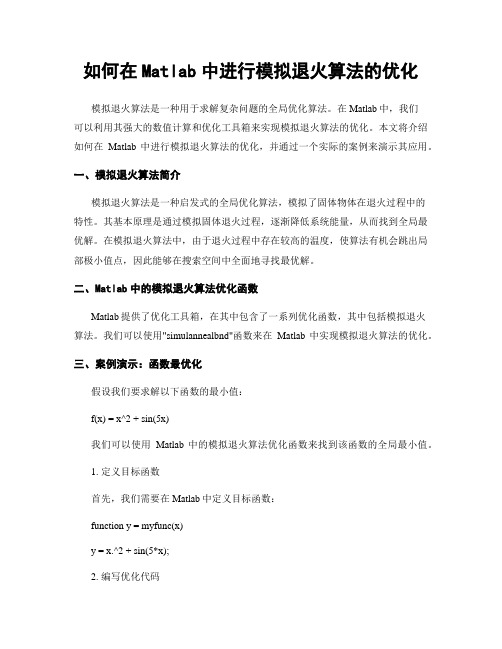
如何在Matlab中进行模拟退火算法的优化模拟退火算法是一种用于求解复杂问题的全局优化算法。
在Matlab中,我们可以利用其强大的数值计算和优化工具箱来实现模拟退火算法的优化。
本文将介绍如何在Matlab中进行模拟退火算法的优化,并通过一个实际的案例来演示其应用。
一、模拟退火算法简介模拟退火算法是一种启发式的全局优化算法,模拟了固体物体在退火过程中的特性。
其基本原理是通过模拟固体退火过程,逐渐降低系统能量,从而找到全局最优解。
在模拟退火算法中,由于退火过程中存在较高的温度,使算法有机会跳出局部极小值点,因此能够在搜索空间中全面地寻找最优解。
二、Matlab中的模拟退火算法优化函数Matlab提供了优化工具箱,在其中包含了一系列优化函数,其中包括模拟退火算法。
我们可以使用"simulannealbnd"函数来在Matlab中实现模拟退火算法的优化。
三、案例演示:函数最优化假设我们要求解以下函数的最小值:f(x) = x^2 + sin(5x)我们可以使用Matlab中的模拟退火算法优化函数来找到该函数的全局最小值。
1. 定义目标函数首先,我们需要在Matlab中定义目标函数:function y = myfunc(x)y = x.^2 + sin(5*x);2. 编写优化代码接下来,我们可以编写优化代码,利用"simulannealbnd"函数进行模拟退火算法的优化:options = saoptimset('Display','iter','TolFun',1e-6);[x,fval] = simulannealbnd(@myfunc, [-10,10],[],[],options);在上述代码中,"options"用于设置优化选项,"@myfunc"是要优化的目标函数,[-10,10]为变量的取值范围,[]表示无约束条件。
MATLAB多目标优化计算方法
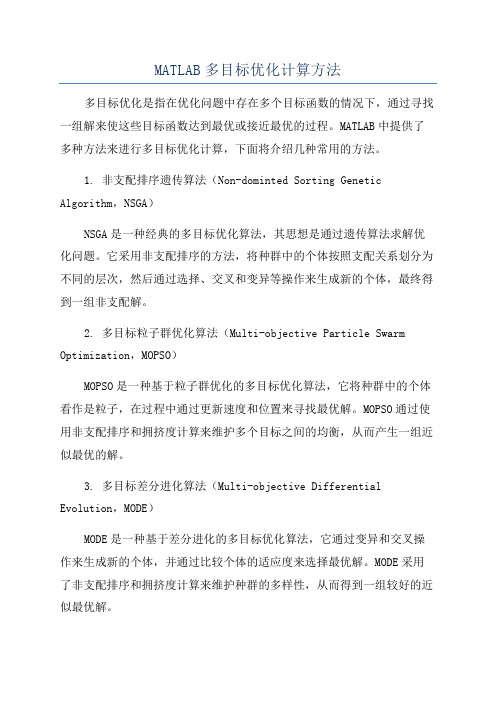
MATLAB多目标优化计算方法多目标优化是指在优化问题中存在多个目标函数的情况下,通过寻找一组解来使这些目标函数达到最优或接近最优的过程。
MATLAB中提供了多种方法来进行多目标优化计算,下面将介绍几种常用的方法。
1. 非支配排序遗传算法(Non-dominted Sorting Genetic Algorithm,NSGA)NSGA是一种经典的多目标优化算法,其思想是通过遗传算法求解优化问题。
它采用非支配排序的方法,将种群中的个体按照支配关系划分为不同的层次,然后通过选择、交叉和变异等操作来生成新的个体,最终得到一组非支配解。
2. 多目标粒子群优化算法(Multi-objective Particle Swarm Optimization,MOPSO)MOPSO是一种基于粒子群优化的多目标优化算法,它将种群中的个体看作是粒子,在过程中通过更新速度和位置来寻找最优解。
MOPSO通过使用非支配排序和拥挤度计算来维护多个目标之间的均衡,从而产生一组近似最优的解。
3. 多目标差分进化算法(Multi-objective Differential Evolution,MODE)MODE是一种基于差分进化的多目标优化算法,它通过变异和交叉操作来生成新的个体,并通过比较个体的适应度来选择最优解。
MODE采用了非支配排序和拥挤度计算来维护种群的多样性,从而得到一组较好的近似最优解。
4. 遗传算法与模拟退火的组合算法(Genetic Algorithm with Simulated Annealing,GASA)GASA是一种结合了遗传算法和模拟退火算法的多目标优化算法。
它首先使用遗传算法生成一组候选解,然后使用模拟退火算法对候选解进行优化,从而得到一组更好的近似最优解。
5. 多目标优化的精英多免疫算法(Multi-objective Optimization based on the Elitism Multi-immune Algorithm,MOEMIA)MOEMIA是一种基于免疫算法的多目标优化算法,它通过模拟生物免疫系统的免疫策略来全局最优解。
遗传算法模拟退火matlab编程
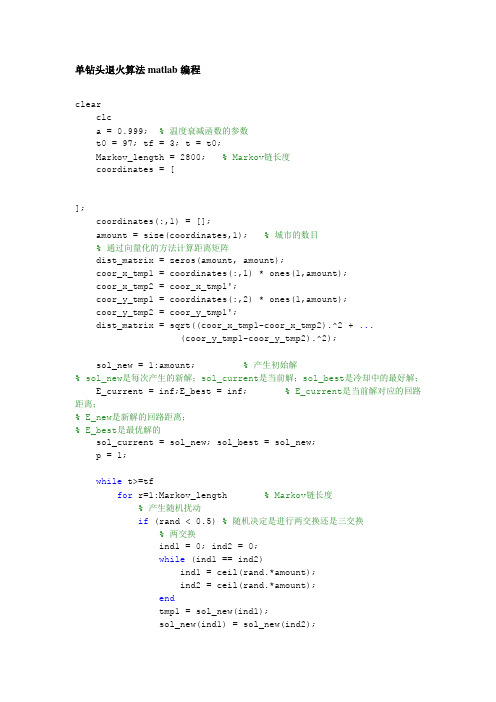
单钻头退火算法matlab编程clearclca = 0.999; % 温度衰减函数的参数t0 = 97; tf = 3; t = t0;Markov_length = 2800; % Markov链长度coordinates = [];coordinates(:,1) = [];amount = size(coordinates,1); % 城市的数目% 通过向量化的方法计算距离矩阵dist_matrix = zeros(amount, amount);coor_x_tmp1 = coordinates(:,1) * ones(1,amount);coor_x_tmp2 = coor_x_tmp1';coor_y_tmp1 = coordinates(:,2) * ones(1,amount);coor_y_tmp2 = coor_y_tmp1';dist_matrix = sqrt((coor_x_tmp1-coor_x_tmp2).^2 + ...(coor_y_tmp1-coor_y_tmp2).^2);sol_new = 1:amount; % 产生初始解% sol_new是每次产生的新解;sol_current是当前解;sol_best是冷却中的最好解; E_current = inf;E_best = inf; % E_current是当前解对应的回路距离;% E_new是新解的回路距离;% E_best是最优解的sol_current = sol_new; sol_best = sol_new;p = 1;while t>=tffor r=1:Markov_length % Markov链长度% 产生随机扰动if (rand < 0.5) % 随机决定是进行两交换还是三交换% 两交换ind1 = 0; ind2 = 0;while (ind1 == ind2)ind1 = ceil(rand.*amount);ind2 = ceil(rand.*amount);endtmp1 = sol_new(ind1);sol_new(ind1) = sol_new(ind2);sol_new(ind2) = tmp1;else% 三交换ind1 = 0; ind2 = 0; ind3 = 0;while (ind1 == ind2) || (ind1 == ind3) ...|| (ind2 == ind3) || (abs(ind1-ind2) == 1) ind1 = ceil(rand.*amount);ind2 = ceil(rand.*amount);ind3 = ceil(rand.*amount);endtmp1 = ind1;tmp2 = ind2;tmp3 = ind3;% 确保ind1 < ind2 < ind3if (ind1 < ind2) && (ind2 < ind3);elseif (ind1 < ind3) && (ind3 < ind2)ind2 = tmp3;ind3 = tmp2;elseif (ind2 < ind1) && (ind1 < ind3)ind1 = tmp2;ind2 = tmp1;elseif (ind2 < ind3) && (ind3 < ind1)ind1 = tmp2;ind2 = tmp3; ind3 = tmp1;elseif (ind3 < ind1) && (ind1 < ind2)ind1 = tmp3;ind2 = tmp1; ind3 = tmp2;elseif (ind3 < ind2) && (ind2 < ind1)ind1 = tmp3;ind2 = tmp2; ind3 = tmp1;endtmplist1 = sol_new((ind1+1):(ind2-1));sol_new((ind1+1):(ind1+ind3-ind2+1)) = ...sol_new((ind2):(ind3));sol_new((ind1+ind3-ind2+2):ind3) = ...tmplist1;end%检查是否满足约束% 计算目标函数值(即内能)E_new = 0;for i = 1 : (amount-1)E_new = E_new + ...dist_matrix(sol_new(i),sol_new(i+1));end% 再算上从最后一个城市到第一个城市的距离%E_new = E_new + ...%dist_matrix(sol_new(amount),sol_new(1));if E_new < E_currentE_current = E_new;sol_current = sol_new;if E_new < E_best% 把冷却过程中最好的解保存下来E_best = E_new;sol_best = sol_new;endelse% 若新解的目标函数值小于当前解的,% 则仅以一定概率接受新解if rand < exp(-(E_new-E_current)./t)E_current = E_new;sol_current = sol_new;elsesol_new = sol_current;endendendt=t.*a; % 控制参数t(温度)减少为原来的a倍enddisp('最优解为:')disp(sol_best)disp('最短距离:')disp(E_best)figure()set(gcf,'Name','monituihuo-sol_best','Color','r')N=length(sol_best);scatter(coordinates(:,1),coordinates(:,2),50,'filled');hold onplot([coordinates(sol_best(1),1),coordinates(sol_best(N),1)],[coo rdinates(sol_best(1),2),coordinates(sol_best(N),2)])set(gca,'Color','g')hold onfor i=2:Nplot([coordinates(sol_best(i-1),1),coordinates(sol_best(i),1)],[c oordinates(sol_best(i-1),2),coordinates(sol_best(i),2)])hold onend。
matlab模拟退火算法

matlab模拟退火算法以matlab模拟退火算法为标题,写一篇文章。
1. 引言模拟退火算法是一种全局优化算法,通过模拟金属退火过程中的晶格结构变化,来搜索问题的最优解。
它广泛应用于组合优化、图论、机器学习等领域。
本篇文章将介绍如何使用matlab实现模拟退火算法,并通过一个简单的例子来演示其应用。
2. 模拟退火算法原理模拟退火算法的核心思想是通过接受较差的解来避免局部最优解,并逐渐降低温度以减小接受较差解的概率。
其基本步骤如下:- 初始化温度和初始解- 在当前温度下,对当前解进行小范围的扰动得到新解- 比较新解与当前解的目标函数值,根据一定的概率选择是否接受新解- 降低温度,重复上述步骤,直到满足停止准则3. matlab实现模拟退火算法在matlab中,我们可以使用内置函数simulannealbnd来实现模拟退火算法。
该函数需要定义目标函数、搜索范围和停止准则等参数。
我们定义一个简单的目标函数,例如求解二元函数f(x,y) = x^2 +y^2的最小值。
我们可以使用matlab的匿名函数来定义目标函数。
```matlabf = @(x) x(1)^2 + x(2)^2;```然后,定义搜索范围,例如x和y的取值范围为[-10, 10]。
```matlablb = [-10, -10];ub = [10, 10];```接着,设置模拟退火算法的参数,包括初始温度、终止温度、退火速率等。
```matlaboptions = optimoptions('simulannealbnd');options.InitialTemperature = 100;options.FunctionT olerance = 1e-6;options.TemperatureFcn = @temperatureexp;options.AnnealingFcn = @annealingboltz;```调用simulannealbnd函数来运行模拟退火算法,并返回最优解和目标函数值。
遗传算法与模拟退火算法结合代码

遗传算法与模拟退火算法结合代码遗传算法和模拟退火算法是两种常用的优化算法,它们分别适用于不同类型的问题。
遗传算法通过模拟自然界的进化原理,使用基因编码和遗传操作来搜索最优解;而模拟退火算法则通过模拟金属退火过程,以一定的概率接受次优解,从而逐步靠近全局最优解。
将遗传算法与模拟退火算法结合起来,可以充分利用两者的优势,提高搜索效率和搜索质量。
其中,遗传算法负责全局搜索,通过种群的进化来搜索解空间;而模拟退火算法则负责局部搜索,在每个个体周围进行扰动搜索,以进一步优化个体的解。
下面是一个简单的遗传算法与模拟退火算法结合的代码示例:```pythonimport random# 生成初始种群def generate_population(population_size, gene_length):population = []for _ in range(population_size):individual = [random.randint(0, 1) for _ inrange(gene_length)]population.append(individual) return population# 计算适应度函数def fitness_function(individual):# TODO: 根据实际问题定义适应度函数 pass# 交叉操作def crossover(parent1, parent2):# TODO: 根据实际问题选择交叉方式pass# 变异操作def mutation(individual):# TODO: 根据实际问题选择变异方式pass# 模拟退火操作def annealing(individual):# TODO: 根据实际问题定义状态转移函数 pass# 遗传算法与模拟退火算法结合def genetic_annealing(population_size, gene_length, max_generations):population = generate_population(population_size, gene_length)for generation in range(max_generations):new_population = []for _ in range(population_size):# 选择个体进行交叉parent1 = random.choice(population)parent2 = random.choice(population)child = crossover(parent1, parent2)# 对交叉后的个体进行变异child = mutation(child)# 对变异后的个体进行模拟退火优化child = annealing(child)new_population.append(child)population = new_population```需要注意的是,上述代码中的交叉、变异和模拟退火等操作均需要根据实际问题进行具体的定义和实现。
模拟退火算法matlab实现
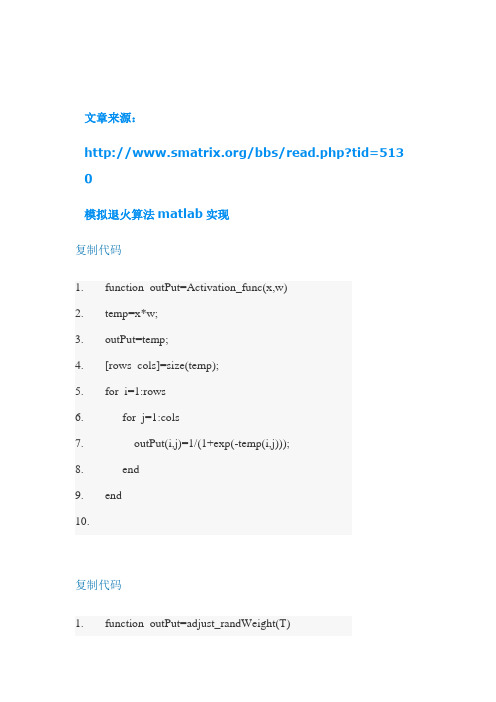
文章来源:/bbs/read.php?tid=513 0模拟退火算法matlab实现复制代码1.function outPut=Activation_func(x,w)2.temp=x*w;3.outPut=temp;4.[rows cols]=size(temp);5.for i=1:rows6.for j=1:cols7.outPut(i,j)=1/(1+exp(-temp(i,j)));8.end9.end10.复制代码1.function outPut=adjust_randWeight(T)2.outPut=zeros(1);3.Delta_W=0.5*T*tan(rand(1));4.outPut=Delta_W;5.复制代码1.clear2.%Receive input3.firstLayer_Neural_Num=input('This is the 1st layer.How many neurals do you want to use? ');4.secondLayer_Neural_Num=input('This is the 2ndlayer.How many neurals do you want to use? ');5.thirdLayer_Neural_Num=input('This is the 3rd layer.How many neurals do you want to use? ');6.%Initialize W and V7.V=rands(firstLayer_Neural_Num,secondLayer_Neural_Num)-0.5;8.W=rands(secondLayer_Neural_Num,thirdLayer_Neural_Num)-0.5;9.V_copy=V;10.W_copy=W;11.12.%Initialize X and Y13.X=[0,0;0,1;1,0];14.Y=[0.6;1;1];15.[x_rows x_cols]=size(X);16.[y_rows y_cols]=size(Y);17.sampNum=x_rows;18.outputMension=y_cols;19.%Initialize Temperature20.Temperature=10;21.22.%Begin to train23.while Temperature>0.924.for sampIndex=1:sampNum25.26.pre_energy=return_energy(X(sampIndex,:),Y(sampIndex,:),V,W);27.28.%initialize p and r29.flag=1;30.31.%pre_adjustWeight is a 1*4 matrix,whichmeans[state,row,col,value]32.%state means if it comes from V ,the state equals 0. Also,if it33.% comes from W, the state equals 1.34. while flag==135.pre_adjustWeight=generate_randWeight(V,W);36.adjust_rows=pre_adjustWeight(2);37.adjust_cols=pre_adjustWeight(3);38.adjust_val=pre_adjustWeight(4);39.40.%Adjust pre_adjustWeight41.Delta_weight=adjust_randWeight(Temperature);42.if pre_adjustWeight(1)==043.V_copy(adjust_rows,adjust_cols)=adjust_val+Delta_weight;44.else45.W_copy(adjust_rows,adjust_cols)=adjust_val+Delta_weight;46.end47.48.pro_energy=return_energy(X,Y,V_copy,W_copy);49.50.Delta_energy=pro_energy-pre_energy;51.52.if Delta_energy>053.r=rand(1);54.p=Temperature/(Temperature^2+pro_energy^2);55.if p<r56.flag=0;57.end58.end59. end60.61.if pre_adjustWeight(1)==062.V(adjust_rows,adjust_cols)=adjust_val+Delta_weight;63.else64.W(adjust_rows,adjust_cols)=adjust_val+Delta_weight;65.end66.67.68.end69.Temperature=0.9*Temperature;70.71.end72.复制代码1.function outPut=generate_randWeight(v,w)2.outPut=zeros(1,4);3.[v_rows v_cols]=size(v);4.[w_rows w_cols]=size(w);5.totalNum=v_rows*v_cols+w_rows*w_cols;6.temp1=round(rand(1)*(totalNum-1))+1;7.if temp1<v_rows*v_cols+18. outPut(1)=0;9. outPut(2)=ceil(temp1/v_cols);10. if temp1/v_cols==outPut(2)11. outPut(3)=v_cols;12. else13. outPut(3)=temp1-floor(temp1/v_cols)*v_cols;14. end15. outPut(4)=v(outPut(2),outPut(3));16.else17. temp2=temp1-v_rows*v_cols;18. outPut(1)=1;19. outPut(2)=ceil(temp2/w_cols);20. if temp2/w_cols==outPut(2)21. outPut(3)=w_cols;22. else23. outPut(3)=temp2-floor(temp2/w_cols)*w_cols;24. end25. outPut(4)=w(outPut(2),outPut(3));26.end27.复制代码1.2.function outPut=return_energy(X,Y,V,W)3.4.outPut=zeros(1);5.6.[rows_Y cols_Y]=size(Y);7.outputMension=cols_Y;8.9.%Initialize E10.E=0;11.12.%Compute the output for the current sample13.output_1=Activation_func(X,V);14.output=Activation_func(output_1,W);15.16.%Compute the energy for the current sample17.for output_Idx=1:outputMension18. Ep=(Y(1,output_Idx)-output(1,output_Idx))^2;19. E=E+Ep;20.end21.22.outPut=E;23.复制代码1.2.function outPut=return_output(X,V,W)3.4.%Compute the output for the current sample5.output_1=Activation_func(X,V);6.output=Activation_func(output_1,W);7.8.outPut=output;9.文章来源:/thread-36175-1-1.html###模拟退火算法matlab实现,大家多多指教模拟退火算法的matlab实现,附程序思想详细介绍!附件所含文件:Activation_func.m代码:复制内容到剪贴板代码:function outPut=Activation_func(x,w)temp=x*w;outPut=temp;[rows cols]=size(temp);for i=1:rowsfor j=1:colsoutPut(i,j)=1/(1+exp(-temp(i,j))); endendadjust_randWeight.m代码:复制内容到剪贴板代码:function outPut=adjust_randWeight(T)outPut=zeros(1);Delta_W=0.5*T*tan(rand(1));outPut=Delta_W;Anneal_realize.m代码:复制内容到剪贴板代码:clear%Receive inputfirstLayer_Neural_Num=input('This is the 1st layer.How many neurals do you want to use? ');secondLayer_Neural_Num=input('This is the 2nd layer.How many neurals do you want to use? ');thirdLayer_Neural_Num=input('This is the 3rd layer.How many neurals do you want to use? ');%Initialize W and VV=rands(firstLayer_Neural_Num,secondLayer_Neural_Num)-0.5; W=rands(secondLayer_Neural_Num,thirdLayer_Neural_Num)-0.5;V_copy=V;W_copy=W;%Initialize X and YX=[0,0;0,1;1,0];Y=[0.6;1;1];[x_rows x_cols]=size(X);[y_rows y_cols]=size(Y);sampNum=x_rows;outputMension=y_cols;%Initialize TemperatureTemperature=10;%Begin to trainwhile Temperature>0.9for sampIndex=1:sampNumpre_energy=return_energy(X(sampIndex,:),Y(sampInde x,:),V,W);%initialize p and rflag=1;%pre_adjustWeight is a 1*4 matrix,which means[state,row,col,value]%state means if it comes from V ,the state equals 0. Also,if it% comes from W, the state equals 1.while flag==1pre_adjustWeight=generate_randWeight(V,W);adjust_rows=pre_adjustWeight(2);adjust_cols=pre_adjustWeight(3);adjust_val=pre_adjustWeight(4);%Adjust pre_adjustWeightDelta_weight=adjust_randWeight(Temperature);if pre_adjustWeight(1)==0V_copy(adjust_rows,adjust_cols)=adjust_val+Del ta_weight;elseW_copy(adjust_rows,adjust_cols)=adjust_val+Del ta_weight;endpro_energy=return_energy(X,Y,V_copy,W_copy);Delta_energy=pro_energy-pre_energy;if Delta_energy>0r=rand(1);p=Temperature/(Temperature^2+pro_energy^2);if p<rflag=0;endendendif pre_adjustWeight(1)==0V(adjust_rows,adjust_cols)=adjust_val+Delta_we ight;elseW(adjust_rows,adjust_cols)=adjust_val+Delta_we ight;endTemperature=0.9*Temperature;endgenerate_randWeight.m代码:复制内容到剪贴板代码:function outPut=generate_randWeight(v,w)outPut=zeros(1,4);[v_rows v_cols]=size(v);[w_rows w_cols]=size(w);totalNum=v_rows*v_cols+w_rows*w_cols;temp1=round(rand(1)*(totalNum-1))+1;if temp1<v_rows*v_cols+1outPut(1)=0;outPut(2)=ceil(temp1/v_cols);if temp1/v_cols==outPut(2)outPut(3)=v_cols;elseoutPut(3)=temp1-floor(temp1/v_cols)*v_cols;outPut(4)=v(outPut(2),outPut(3));elsetemp2=temp1-v_rows*v_cols;outPut(1)=1;outPut(2)=ceil(temp2/w_cols);if temp2/w_cols==outPut(2)outPut(3)=w_cols;elseoutPut(3)=temp2-floor(temp2/w_cols)*w_cols; endoutPut(4)=w(outPut(2),outPut(3));endreturn_energy.m代码:复制内容到剪贴板代码:function outPut=return_energy(X,Y,V,W)outPut=zeros(1);[rows_Y cols_Y]=size(Y);outputMension=cols_Y;%Initialize EE=0;%Compute the output for the current sampleoutput_1=Activation_func(X,V);output=Activation_func(output_1,W);%Compute the energy for the current samplefor output_Idx=1:outputMensionEp=(Y(1,output_Idx)-output(1,output_Idx))^2; E=E+Ep;endoutPut=E;return_output.m代码:复制内容到剪贴板代码:function outPut=return_output(X,V,W)%Compute the output for the current sample output_1=Activation_func(X,V);output=Activation_func(output_1,W);outPut=output;。
matlab智能算法代码
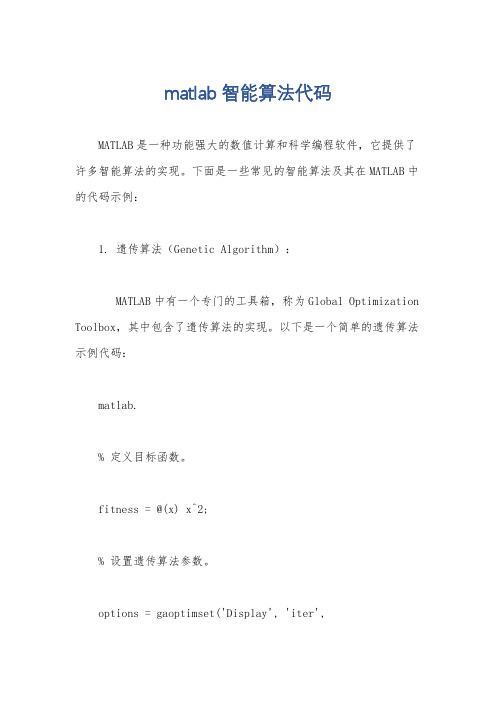
matlab智能算法代码MATLAB是一种功能强大的数值计算和科学编程软件,它提供了许多智能算法的实现。
下面是一些常见的智能算法及其在MATLAB中的代码示例:1. 遗传算法(Genetic Algorithm):MATLAB中有一个专门的工具箱,称为Global Optimization Toolbox,其中包含了遗传算法的实现。
以下是一个简单的遗传算法示例代码:matlab.% 定义目标函数。
fitness = @(x) x^2;% 设置遗传算法参数。
options = gaoptimset('Display', 'iter','PopulationSize', 50);% 运行遗传算法。
[x, fval] = ga(fitness, 1, options);2. 粒子群优化算法(Particle Swarm Optimization):MATLAB中也有一个工具箱,称为Global Optimization Toolbox,其中包含了粒子群优化算法的实现。
以下是一个简单的粒子群优化算法示例代码:matlab.% 定义目标函数。
fitness = @(x) x^2;% 设置粒子群优化算法参数。
options = optimoptions('particleswarm', 'Display','iter', 'SwarmSize', 50);% 运行粒子群优化算法。
[x, fval] = particleswarm(fitness, 1, [], [], options);3. 支持向量机(Support Vector Machine):MATLAB中有一个机器学习工具箱,称为Statistics and Machine Learning Toolbox,其中包含了支持向量机的实现。
模拟退火算法及其MATLAB实现

4.若 E 0 ,则新解xj被接受,作为新的当前解;
若
E, 则0 新解xj按概率
Ti为当前温度。
exp( 接E )受,
Ti
5.在温度Ti下,重复Lk次的扰动和接受过程,即执 行步骤(3)与(4)。
6.判断T是否已经达到Tf,是,则终止算法;否, 则转到步骤(2)继续执行
9
算法程序框图
初始化
随机产生初始解
模拟退火算法 及其MATLAB实现
算法基本理论部分
算法的简单介绍及其基本思想
模拟退火算法形成于20世纪80年代初,其思想来源 于固体退火过程,即将固体加热到足够高的温度, 再缓慢冷却;升温时,固体内部粒子随温度的升高 变为无序状,内能增大,缓慢冷却过程中粒子熵减 小,趋于有序。理论上讲,若冷却过程足够的缓慢, 那么在冷却中任意温度固体都会达到一个热平衡, 冷却到低温时将达到这一个低温下的最小内能状态。
四、参数的选择 3.Markov链长度
Markov链长度的选取原则是:一般取
Lk 100 n
n为问题规模
17
算法的MATLAB实现
TSP问题简介
一名商人要到n个不同的城市旅游,每 两个城市i和j之间的距离为dij,如何 选择一条路径使得商人每个城市走一 遍后回到起点,所走的总路径最短。
18
算法设计步骤的简单介绍
2
Metropolis准则的来源
冷却过程中,任一恒定温度都能达到一个热平衡。
由于物理系统总是趋向于能量最低,然而分子的热
运动则趋向于破坏这种低能量的状态,故只需要着
重采取贡献比较大的状态即可以达到比较好的效果。
于是1953年Metropolis提出了一个重要性采样的方
法:从当前状态i生成新状态j,若新状态的内能小
- 1、下载文档前请自行甄别文档内容的完整性,平台不提供额外的编辑、内容补充、找答案等附加服务。
- 2、"仅部分预览"的文档,不可在线预览部分如存在完整性等问题,可反馈申请退款(可完整预览的文档不适用该条件!)。
- 3、如文档侵犯您的权益,请联系客服反馈,我们会尽快为您处理(人工客服工作时间:9:00-18:30)。
单钻头退火算法matlab编程
clear
clc
a = 0.999; % 温度衰减函数的参数
t0 = 97; tf = 3; t = t0;
Markov_length = 2800; % Markov链长度
coordinates = [
];
coordinates(:,1) = [];
amount = size(coordinates,1); % 城市的数目
% 通过向量化的方法计算距离矩阵
dist_matrix = zeros(amount, amount);
coor_x_tmp1 = coordinates(:,1) * ones(1,amount);
coor_x_tmp2 = coor_x_tmp1';
coor_y_tmp1 = coordinates(:,2) * ones(1,amount);
coor_y_tmp2 = coor_y_tmp1';
dist_matrix = sqrt((coor_x_tmp1-coor_x_tmp2).^2 + ...
(coor_y_tmp1-coor_y_tmp2).^2);
sol_new = 1:amount; % 产生初始解
% sol_new是每次产生的新解;sol_current是当前解;sol_best是冷却中的最好解; E_current = inf;E_best = inf; % E_current是当前解对应的回路距离;
% E_new是新解的回路距离;
% E_best是最优解的
sol_current = sol_new; sol_best = sol_new;
p = 1;
while t>=tf
for r=1:Markov_length % Markov链长度
% 产生随机扰动
if (rand < 0.5) % 随机决定是进行两交换还是三交换
% 两交换
ind1 = 0; ind2 = 0;
while (ind1 == ind2)
ind1 = ceil(rand.*amount);
ind2 = ceil(rand.*amount);
end
tmp1 = sol_new(ind1);
sol_new(ind1) = sol_new(ind2);
sol_new(ind2) = tmp1;
else
% 三交换
ind1 = 0; ind2 = 0; ind3 = 0;
while (ind1 == ind2) || (ind1 == ind3) ...
|| (ind2 == ind3) || (abs(ind1-ind2) == 1) ind1 = ceil(rand.*amount);
ind2 = ceil(rand.*amount);
ind3 = ceil(rand.*amount);
end
tmp1 = ind1;tmp2 = ind2;tmp3 = ind3;
% 确保ind1 < ind2 < ind3
if (ind1 < ind2) && (ind2 < ind3)
;
elseif (ind1 < ind3) && (ind3 < ind2)
ind2 = tmp3;ind3 = tmp2;
elseif (ind2 < ind1) && (ind1 < ind3)
ind1 = tmp2;ind2 = tmp1;
elseif (ind2 < ind3) && (ind3 < ind1)
ind1 = tmp2;ind2 = tmp3; ind3 = tmp1;
elseif (ind3 < ind1) && (ind1 < ind2)
ind1 = tmp3;ind2 = tmp1; ind3 = tmp2;
elseif (ind3 < ind2) && (ind2 < ind1)
ind1 = tmp3;ind2 = tmp2; ind3 = tmp1;
end
tmplist1 = sol_new((ind1+1):(ind2-1));
sol_new((ind1+1):(ind1+ind3-ind2+1)) = ...
sol_new((ind2):(ind3));
sol_new((ind1+ind3-ind2+2):ind3) = ...
tmplist1;
end
%检查是否满足约束
% 计算目标函数值(即内能)
E_new = 0;
for i = 1 : (amount-1)
E_new = E_new + ...
dist_matrix(sol_new(i),sol_new(i+1));
end
% 再算上从最后一个城市到第一个城市的距离
%E_new = E_new + ...
%dist_matrix(sol_new(amount),sol_new(1));
if E_new < E_current
E_current = E_new;
sol_current = sol_new;
if E_new < E_best
% 把冷却过程中最好的解保存下来
E_best = E_new;
sol_best = sol_new;
end
else
% 若新解的目标函数值小于当前解的,
% 则仅以一定概率接受新解
if rand < exp(-(E_new-E_current)./t)
E_current = E_new;
sol_current = sol_new;
else
sol_new = sol_current;
end
end
end
t=t.*a; % 控制参数t(温度)减少为原来的a倍
end
disp('最优解为:')
disp(sol_best)
disp('最短距离:')
disp(E_best)
figure()
set(gcf,'Name','monituihuo-sol_best','Color','r')
N=length(sol_best);
scatter(coordinates(:,1),coordinates(:,2),50,'filled');
hold on
plot([coordinates(sol_best(1),1),coordinates(sol_best(N),1)],[coo rdinates(sol_best(1),2),coordinates(sol_best(N),2)])
set(gca,'Color','g')
hold on
for i=2:N
plot([coordinates(sol_best(i-1),1),coordinates(sol_best(i),1)],[c oordinates(sol_best(i-1),2),coordinates(sol_best(i),2)])
hold on
end。
